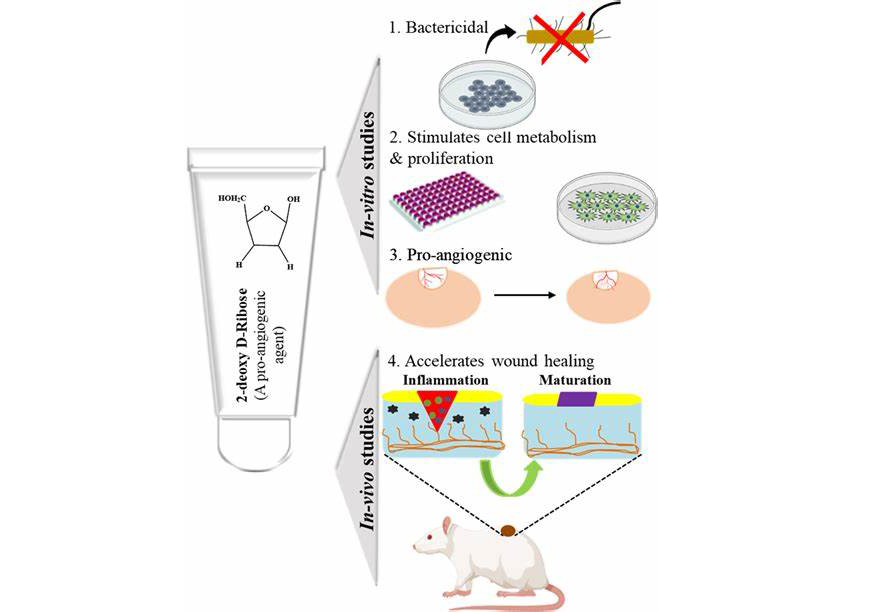2-Deoxy-D-Ribose is a monosaccharide, specifically a sugar, that plays a crucial role in the structure and function of DNA (deoxyribonucleic acid). It is a derivative of ribose, with the key difference being the absence of a hydroxyl group (-OH) at the 2′ position of the carbon chain, hence the name “2-Deoxy.” This absence of a hydroxyl group makes the sugar more chemically stable compared to ribose, which is critical for DNA’s function in genetic material storage and replication.
1. Chemical Structure and Properties
2-Deoxy-D-Ribose is a pentose (five-carbon) sugar, and its chemical formula is C5H10O4. It is similar in structure to ribose, but in 2-deoxy-D-ribose, the hydroxyl group (-OH) at the second carbon is replaced by a hydrogen atom (-H). The structure consists of:
- A five-membered ring (furanose form), where the carbon atoms are labeled as C1′, C2′, C3′, C4′, and C5′.
- Hydroxyl groups on C3′ and C4′, and a hydrogen atom on C2′.
The absence of the hydroxyl group at the 2′ position of the sugar backbone in DNA is what differentiates it from the sugar in RNA, where ribose has the -OH group at C2′.

2. Role in DNA
2-Deoxy-D-Ribose is the sugar component of the nucleotides that make up DNA (deoxyribonucleic acid). In a nucleotide, 2-Deoxy-D-Ribose is covalently bonded to a nitrogenous base (purine or pyrimidine) and a phosphate group. These components form the basic building blocks of DNA, known as nucleosides when the base is attached to the sugar and nucleotides when the phosphate group is also attached.
- Structure of DNA nucleotides: Each nucleotide consists of one of the four nitrogenous bases (adenine, thymine, cytosine, or guanine), a 2-Deoxy-D-Ribose sugar, and a phosphate group. The bases pair to form the double helix structure of DNA (adenine with thymine and cytosine with guanine), while the sugar-phosphate backbone holds the structure together.
- Function: The absence of the hydroxyl group at the 2′ carbon in 2-Deoxy-D-Ribose makes DNA more stable than RNA. The absence of the 2′-hydroxyl group prevents the hydrolysis of the phosphodiester bond in the DNA backbone, which is a significant contributor to RNA’s relative instability compared to DNA.
3. Metabolism of 2-Deoxy-D-Ribose
2-Deoxy-D-Ribose is synthesized in the body through the pentose phosphate pathway. It can also be derived from ribose through the action of specific enzymes. One key enzyme involved in the conversion is ribose-5-phosphate reductase, which reduces ribose-5-phosphate to 2-deoxy-D-ribose-5-phosphate.
- Conversion to nucleotides: After its synthesis, 2-Deoxy-D-Ribose is incorporated into the DNA backbone. This process is crucial for the growth of cells, as DNA synthesis is required for cell division.
- Deoxyribonucleotide synthesis: The addition of phosphate groups at various positions and coupling with the nitrogenous base form the building blocks (deoxyribonucleoside monophosphates, e.g., dAMP, dCMP, dGMP, dTMP) necessary for DNA replication and repair.

4. Comparison with Ribose (RNA)
The key distinction between ribose (found in RNA) and 2-Deoxy-D-Ribose (found in DNA) is the presence of the hydroxyl group at the second carbon in ribose, whereas 2-deoxy-D-ribose lacks this group. This difference has significant biological consequences:
- Stability: The absence of the 2′ hydroxyl group in 2-Deoxy-D-Ribose contributes to the chemical stability of DNA, making it less prone to hydrolysis and degradation compared to RNA.
- Functionality: RNA, due to its -OH group at the 2′ position, is more reactive and less stable, which is essential for its role in catalysis and transient functions in the cell.
5. Applications and Uses
- Synthetic Chemistry: 2-Deoxy-D-Ribose has been used in the synthesis of artificial nucleic acids and in biotechnology for creating modified DNA and RNA molecules.
- Pharmaceutical Research: Some analogs of 2-Deoxy-D-Ribose are being studied for their potential role in anti-viral therapies, as they may disrupt viral DNA replication.
- Biochemical Research: Researchers use 2-Deoxy-D-Ribose in experiments related to DNA synthesis, repair mechanisms, and the study of nucleic acids.
6. Structural Modifications
Various structural modifications of 2-Deoxy-D-Ribose and its derivatives have been explored for their application in genetic research, antiviral drugs, and gene therapies. For example:
- 2-Deoxy analogs: Modified 2-Deoxy-D-Ribose derivatives are used in certain antiviral drugs like Zidovudine (AZT), which is used in the treatment of HIV. AZT is a thymidine analog and works by inhibiting reverse transcriptase, an enzyme essential for HIV replication.
- Prodrugs: Some prodrugs are designed to deliver the active drug after conversion inside cells, with 2-Deoxy-D-Ribose playing a key role in drug delivery systems.

7. Concluding Remarks
2-Deoxy-D-Ribose is a simple yet crucial molecule in the world of biochemistry and genetics. Its role as the sugar component of DNA is essential for life as we know it. Its structure, devoid of the hydroxyl group at the 2′ position, is central to the stability and integrity of the genetic material that governs biological processes across all living organisms.
In summary, 2-Deoxy-D-Ribose is integral to DNA’s structure, influencing its stability, replication, and function. Its modifications have opened doors to the development of therapeutic agents, making it an important molecule both in biology and medicine.
